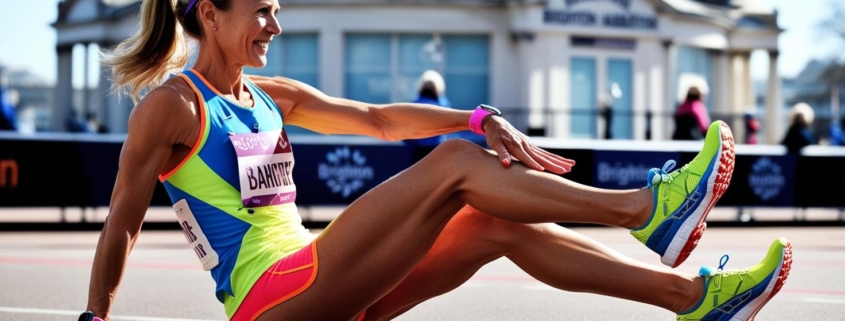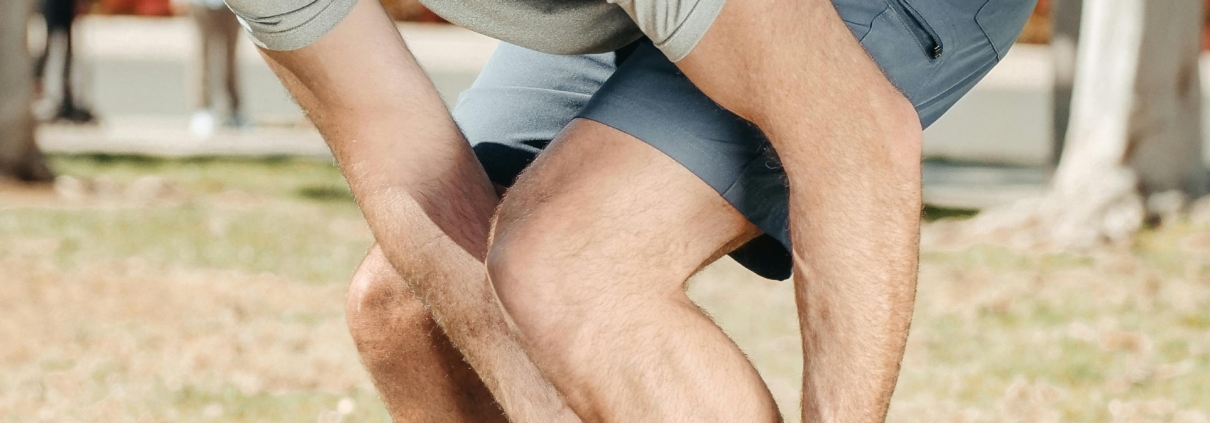5 Common Marathon Injuries (and How to Prevent Them Like a Pro)
Whether you’re gearing up for the Brighton Marathon, pounding the Hove promenade, or clocking in early-morning seafront miles, marathon training is no joke. While it’s hugely rewarding, it also brings a few aches, pains, and potential injuries if you’re not careful.
As a local personal trainer who’s worked with dozens of runners in Brighton & Hove, I’ve seen these five injuries pop up again and again. But the good news? Most are 100% preventable with the right prep, strength work, and awareness.
Let’s break them down — with real solutions that actually work.

Brighton marathon runner stretching
1. Runner’s Knee (Patellofemoral Pain Syndrome)
What it feels like:
A nagging ache around or behind the kneecap, especially when running downhill, squatting, or climbing stairs.
Why it happens:
Poor hip stability, weak glutes, and overuse cause the knee to track poorly — increasing friction on the patella.
Prevention Tips:
-
Strengthen your glutes with exercises like step-downs and clamshells.
-
Don’t skip mobility: tight hips and quads are usually lurking in the background.
-
Gradually increase mileage — avoid the “too much too soon” trap.
Pro Tip: I had a client prepping for Brighton Marathon who came in with knee pain after hitting 16km for the first time. We added targeted glute work and running drills, and she was pain-free by race day.
🔗 Read more about glute activation
2. Plantar Fasciitis
What it feels like:
Sharp heel or arch pain, usually first thing in the morning or after long periods of sitting.
Why it happens:
Repetitive pounding without proper foot strength or recovery can inflame the fascia under the foot.
Prevention Tips:
-
Use a lacrosse ball to roll out your arches daily.
-
Strengthen the foot with toe towel scrunches and barefoot balance work.
-
Don’t run in worn-out shoes. (Seriously.)
3. Shin Splints (Medial Tibial Stress Syndrome)
What it feels like:
Throbbing pain along the inner shin during or after running — early warning of potential stress injury.
Why it happens:
Training spikes, weak shin muscles, and poor running form all contribute.
Prevention Tips:
-
Add toe raises and heel walks into your warm-up.
-
Cross-train with cycling or swimming on recovery days.
-
Increase mileage by no more than 10% per week.
🔗 How to fix shin splits in 3 simple steps
4. IT Band Syndrome
What it feels like:
Sharp pain on the outer knee, often worse going downhill or after longer runs.
Why it happens:
The IT band gets tight or irritated due to weak hips and poor gait mechanics.
Prevention Tips:
-
Strengthen lateral glutes with lateral band walks.
-
Avoid overstriding — work on your cadence and posture.
-
Foam roll the surrounding muscles, not just the IT band itself.
Pro tip: Get resistance bands from Decathlon.
5. Stress Fractures
What it feels like:
Localized bone pain (shin, foot, or hip) that worsens with impact and doesn’t improve with rest.
Why it happens:
Under-recovery, low bone density, and poor fuelling habits (especially under-eating!) are key factors.
Prevention Tips:
-
Fuel well, especially with enough carbs and calcium-rich foods.
-
Incorporate loaded carries and step-ups to build bone resilience.
-
Prioritize sleep and rest days — your bones do too!
🔗 Get some marathon training recipes
Your Takeaway
Marathon training isn’t just about miles — it’s about smart prep, strength, and recovery. If you’re in Brighton or Hove and training for your next big race, don’t wait until an injury sidelines you. Be proactive, build your base, and train like the whole body matters.
I’ve put together a 4-week strength and mobility plan designed specifically for runners like you. Each session takes just 20–30 minutes and fits easily alongside your run training. Think glute work, foot strength, smart mobility — all the essentials that most runners skip (until something hurts).
Here’s what’s inside:
-
3 easy-to-follow sessions per week
-
Step-by-step exercises with reps and sets
-
Focus on hips, knees, feet, and core
-
Built by a Brighton-based running coach
👉 Click here to download the free plan now and get stronger, smarter, and ready to run your best — without getting sidelined.
Need support?
We offer 1:1 running assessments, injury prehab, and tailored strength plans right here in Brighton.
📩 Book your free assessment here



